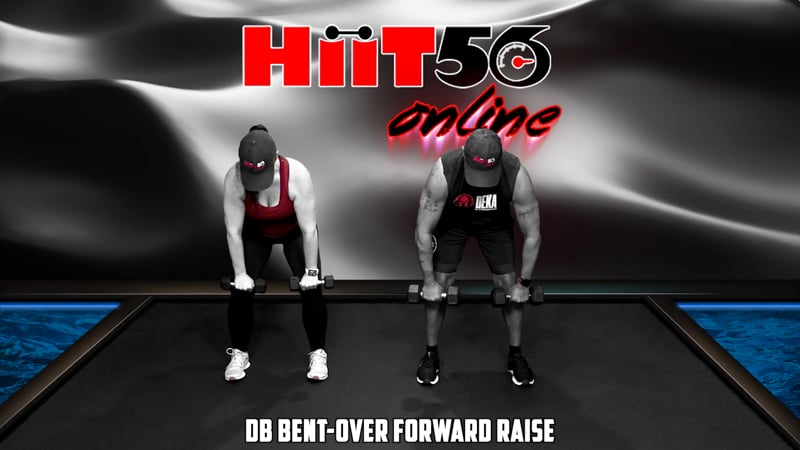DB Bent-Over Forward Raise
- Duration: 00:00:24
**Body Part/Parts Used:**
- Deltoids (specifically anterior deltoids)
- Serratus Anterior
- Upper Pectoralis Major
**Equipment Needed:**
- Dumbbell(s)
- Optional: Workout mat or bench for support
**Difficulty:**
- Intermediate
#### Directions on How to Perform the Exercise:
1. **Starting Position**: Stand with your feet shoulder-width apart. Hold a dumbbell in each hand with a neutral grip (palms facing your body). Bend at the hips to lower your torso until it's almost parallel to the floor.
2. **Arm Position**: Extend your arms straight down, keeping them close to your legs. This is your starting position.
3. **Engage Core**: Tighten your core and maintain a straight back throughout the movement to protect your spine.
4. **Raise Arms**: Without bending your elbows, lift the dumbbells straight in front of you until they reach shoulder height. Ensure your arms remain straight throughout this phase. The motion should be primarily driven by the shoulders.
5. **Pause and Lower**: Hold the lifted position briefly to maximize muscle engagement. Slowly lower the dumbbells back to the starting position.
6. **Repetition**: Complete the desired number of repetitions and sets, making sure to maintain proper form throughout.
#### What It Does and Benefits:
- **Muscle Building**: Targets the anterior deltoids and engages the serratus anterior and upper pectoralis major, which is great for building upper body strength and sculpting your shoulders.
- **Core Engagement**: Keeping your torso almost parallel to the ground engages your core, aiding in stability and spinal support.
- **Improved Shoulder Mobility**: This exercise can help improve shoulder mobility by taking them through a full range of motion.
- **Functional Strength**: The lifting motion mimics everyday activities like lifting items overhead, making it a functional exercise that helps in daily life.
- **Isolation**: This is a fantastic isolation exercise that allows for individual muscle targeting, beneficial for muscle imbalances or rehabilitation.
This exercise is a good fit for those looking to focus on shoulder development while also engaging core and other stabilizing muscles. It can be easily incorporated into HIIT circuits for that extra burn.
- Deltoids (specifically anterior deltoids)
- Serratus Anterior
- Upper Pectoralis Major
**Equipment Needed:**
- Dumbbell(s)
- Optional: Workout mat or bench for support
**Difficulty:**
- Intermediate
#### Directions on How to Perform the Exercise:
1. **Starting Position**: Stand with your feet shoulder-width apart. Hold a dumbbell in each hand with a neutral grip (palms facing your body). Bend at the hips to lower your torso until it's almost parallel to the floor.
2. **Arm Position**: Extend your arms straight down, keeping them close to your legs. This is your starting position.
3. **Engage Core**: Tighten your core and maintain a straight back throughout the movement to protect your spine.
4. **Raise Arms**: Without bending your elbows, lift the dumbbells straight in front of you until they reach shoulder height. Ensure your arms remain straight throughout this phase. The motion should be primarily driven by the shoulders.
5. **Pause and Lower**: Hold the lifted position briefly to maximize muscle engagement. Slowly lower the dumbbells back to the starting position.
6. **Repetition**: Complete the desired number of repetitions and sets, making sure to maintain proper form throughout.
#### What It Does and Benefits:
- **Muscle Building**: Targets the anterior deltoids and engages the serratus anterior and upper pectoralis major, which is great for building upper body strength and sculpting your shoulders.
- **Core Engagement**: Keeping your torso almost parallel to the ground engages your core, aiding in stability and spinal support.
- **Improved Shoulder Mobility**: This exercise can help improve shoulder mobility by taking them through a full range of motion.
- **Functional Strength**: The lifting motion mimics everyday activities like lifting items overhead, making it a functional exercise that helps in daily life.
- **Isolation**: This is a fantastic isolation exercise that allows for individual muscle targeting, beneficial for muscle imbalances or rehabilitation.
This exercise is a good fit for those looking to focus on shoulder development while also engaging core and other stabilizing muscles. It can be easily incorporated into HIIT circuits for that extra burn.
Categories:
